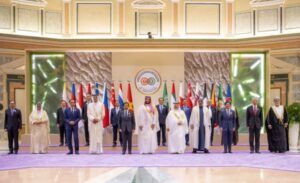From October 22-24, 2024, the BRICS Summit is being held in Kazan, attracting significant attention from both the bloc’s participants and the international community. Central Asian countries, including Kazakhstan and Uzbekistan, are showing growing interest in cooperating with BRICS, viewing it as an opportunity for economic growth and strengthening political influence. But, how will Central Asian countries engage with BRICS, their expectations for the upcoming summit, and the impact of sanctions on their currency and financial spheres?
Overall, BRICS is being formed as an alternative to existing global platforms, and therefore, Central Asian countries will increasingly seek to build relationships with this platform. The desire of Central Asian countries to align more closely with the so-called Global South is demonstrated by the unified voting of all countries in the region for UN resolutions condemning Israel’s actions in the Gaza Strip.
The interest of the region’s countries in BRICS can be illustrated by the two largest economies in the region: Kazakhstan and Uzbekistan.

Kazakhstan
Kazakhstan takes an active position regarding cooperation with BRICS. While the country seeks to strengthen its partnerships with bloc members such as Russia and China, its official accession to the bloc has been postponed for now. Kazakhstan sees BRICS as a promising opportunity to develop mutually beneficial relationships with other participants, including South Africa and Brazil. However, as Kazakh authorities note, there are currently no clear criteria or mechanisms for expanding BRICS membership, making accession premature.
Kazakh President Kassym-Jomart Tokayev participated in the 2023 BRICS Summit via videoconference, representing Kazakhstan as the chair of the Shanghai Cooperation Organization (SCO). In his speech, he emphasized the importance of strengthening cooperation between BRICS and the SCO to address global challenges, proposed uniting efforts in the fields of the digital economy, cybersecurity, and e-commerce, and invited BRICS Plus countries to participate in the upcoming SCO digital forum in Kazakhstan. He also highlighted climate issues and proposed declaring 2024 the Year of Ecology within the SCO. Tokayev called for the depoliticization of global food and fertilizer supplies and expressed Kazakhstan’s readiness to contribute to strengthening cooperation with BRICS and the African Union.
Uzbekistan
Uzbekistan is also showing interest in cooperating with BRICS. Experts emphasize that participating in the BRICS’s projects could bring significant political and economic benefits to the country, including strengthening trade and economic ties and participating in global initiatives carried out on the BRICS platform. For Uzbekistan, BRICS cooperation is seen to diversify foreign economic relations. The President of Uzbekistan, in his speech at the High-Level Dialogue on Global Development in the BRICS Plus format, stressed the importance of inclusive partnerships in promoting the Sustainable Development Agenda. He noted global transformations and increasing tensions in the world, emphasizing that Uzbekistan continues reforms focused on human interests. The country’s main priorities include improving governance, reducing poverty, and fostering inclusive social development.
The President also spoke about the importance of international cooperation, including the South-South format. He proposed creating a BRICS Plus business forum to promote industrial cooperation and infrastructure modernization, as well as deepening cooperation in artificial intelligence, biotechnology, and innovations. He suggested strengthening the region’s transport and communication connectivity with the North-South and East-West routes.
General Trends in the Region
Central Asian countries find themselves in a complex geopolitical situation that requires balancing between different international blocs. Amid growing tensions between Western countries and nations like Russia, China, and Iran, the countries of the region are seeking alternative paths to ensure their economic and political stability. In this context, BRICS is becoming an attractive partner for strategic cooperation and the diversification of foreign economic ties. Central Asian states see BRICS as an opportunity to expand economic relations and strengthen their political influence on the international stage. This is reflected in the availability of a new platform for promoting their vision of addressing global issues, as exemplified by the speeches of the Presidents of Kazakhstan and Uzbekistan at BRICS summits.
The Upcoming BRICS Summit in Kazan
The BRICS Summit is an important event for the bloc’s participants and potential partners from Central Asia. This year, Russia is chairing BRICS, giving the summit special significance. One of the key topics will be the further expansion of the bloc’s membership. In early 2024, six new countries joined BRICS, including Egypt, Iran, the UAE, Saudi Arabia, and Ethiopia. At the summit, applications for membership from other countries, such as Turkey, Kazakhstan, and Azerbaijan, are expected to be considered. This demonstrates BRICS’ desire to strengthen its influence and expand its geopolitical presence.
The summit will focus on developing economic partnerships and increasing settlements in national currencies, which aligns with BRICS’ strategy to reduce dependence on the US dollar. Discussions will address opportunities to increase mutual trade and investment, as well as create new economic initiatives. An important aspect will be the increased role of BRICS countries in the international monetary and financial system. This includes the development of interbank cooperation and collaboration between the tax and customs authorities of member states. Such measures are aimed at strengthening the bloc’s financial independence and reducing vulnerability to external economic shocks.
Humanitarian cooperation will also be an important part of the summit. Interaction in the fields of culture, sports, and youth exchanges aims to strengthen intercultural ties and create a solid social foundation for long-term cooperation. The political agenda of the summit will include discussions on strengthening a multipolar world order and seeking collective solutions to modern global challenges, such as security, sustainable development, and climate change.
Thus, the upcoming BRICS Summit in Kazan will serve as an important platform for discussing strategic issues and strengthening cooperation between bloc member states.
The Impact of Sanctions on Central Asia’s Currency and Financial Sphere
Sanctions against Russia have had a significant impact on the currency and financial sectors of Central Asian countries. These countries, with close economic ties to Russia, have faced several challenges and changes in their financial systems.
Central Asian banks have increasingly refused to process payments for Russian companies due to fears of secondary sanctions. This applies to transactions in both rubles and friendly currencies. Banks are striving to avoid sanctions, leading to payment suspensions and longer transaction times. Additionally, Central Asian countries have been forced to impose restrictions on the use of Russian payment systems, such as the MIR system, to avoid sanction risks. This complicates financial operations and limits access to international financial markets.
Despite the difficulties, some countries in the region benefit from parallel trade with Russia. They gain from increased exports and the inflow of human capital from Russia. However, this also creates inflationary pressures and social challenges, such as rising housing and service prices. Under sanction pressure, Central Asian countries are increasing the share of settlements in national currencies, such as the tenge and som. This helps reduce dependence on the US dollar and strengthen the region’s financial independence.
De-dollarization: Reasons and Consequences
Switching to settlements in national currencies is a strategic step for Central Asian countries to adapt to new economic conditions.
Settlements between countries in the region and Russia are increasingly being made in national currencies. For example, the share of ruble and tenge settlements in foreign trade within the CIS has significantly increased, allowing them to bypass some restrictions restrictions related to the use of Western currencies. Some countries in the region benefit from parallel trade with Russia, which helps increase exports. This creates additional pressure on currency markets and contributes to financial stability. Experts note that it is necessary to introduce digital currencies and settlement and payment infrastructure within the BRICS framework.
The transition to national currencies also allows Central Asian countries to strengthen their financial independence and reduce reliance on Western currencies. This is especially important in times of global market instability and increased sanction pressure.
Risks and Challenges of De-dollarization
However, the transition to settlements in national currencies is accompanied by several risks and challenges. Central Asian banks, fearing sanctions, have increasingly refused payments from Russian businesses, complicating transactions even in national currencies. Stricter bank compliance leads to longer payment processing times, as additional documents and explanations about transactions are required, slowing down the settlement process and creating additional difficulties for businesses.
Sanctions also lead to increased volatility in currency markets, which can negatively affect the stability of national currencies. This creates additional risks for companies engaged in foreign economic activities, as exchange rate fluctuations can lead to financial losses. Moreover, sanctions limit access to international financial markets and Western financing, which could negatively impact the economies of Central Asian countries, especially Kazakhstan, where a large portion of exports is oriented towards the European Union.
Examples of Successful De-dollarization
Several countries have successfully transitioned to using national currencies in international settlements. China actively promotes the use of the yuan in international trade. Agreements on yuan settlements with countries like Saudi Arabia and Russia help strengthen the yuan as an international currency and expand its use in global trade. Russia began the de-dollarization process back in 2014 and intensified it after the introduction of Western sanctions. Active use of the ruble in foreign trade settlements, especially with partners from BRICS and the CIS, has allowed for the reduction of risks associated with the dollar and strengthened economic security. India is also taking steps to increase the share of the rupee in international settlements. Agreements on mutual settlements in national currencies with partners like Malaysia and Russia help strengthen the rupee and reduce dependence on the dollar.
The Impact of De-dollarization on the Economy
The use of national currencies allows countries to reduce their dependence on the U.S. dollar. The shift to national currencies can help minimize risks associated with fluctuations in the dollar’s exchange rate and strengthen trade ties between partner countries. However, this transition also entails certain risks, such as exchange rate volatility and the need to create reliable financial mechanisms to maintain the stability of national currencies.
Increased volatility in currency markets can complicate trade transactions, as businesses face uncertainties regarding the value of their contracts. Moreover, the absence of a well-developed infrastructure for international settlements in national currencies can lead to difficulties in managing cross-border payments. In response to these challenges, Central Asian countries are working on enhancing their financial systems and improving the mechanisms for settlements in national currencies.
Additionally, the creation of new regional financial institutions and the strengthening of cooperation within frameworks such as BRICS could provide alternative solutions for facilitating financial transactions. These initiatives are aimed at reducing dependency on Western financial systems and promoting the use of national currencies in international trade and investment.
Conclusion
The Summit in Kazan represents an important milestone in the development of international cooperation and the strengthening of the bloc’s global influence. Central Asian countries, such as Kazakhstan and Uzbekistan, see BRICS as an opportunity to expand economic ties and enhance their political influence. However, the integration process comes with several challenges, including the impact of sanctions and the need for de-dollarization.
To achieve successful cooperation and sustainable development, Central Asian countries must continue to diversify their foreign economic relations, strengthen their financial systems, and develop strategies to minimize risks. The BRICS Summit in Kazan will serve as a key platform for discussing these issues and finding joint solutions that will contribute to the stability and prosperity of the region.
While Central Asia’s engagement with BRICS holds promise for economic growth and geopolitical influence, countries in the region must carefully navigate the challenges of sanctions and the global shift away from reliance on the U.S. dollar. Effective participation in the BRICS framework can provide new opportunities for trade, investment, and cooperation, ultimately helping Central Asian nations secure a stronger foothold in the multipolar world order.
Written by: Eldaniz Gusseinov
Eldaniz Gusseinov, is a columnist at Daryo and is a Non-Resident Research Fellow at Haydar Aliyev Center for Eurasian Studies of the Ibn Haldun University, Istanbul.




